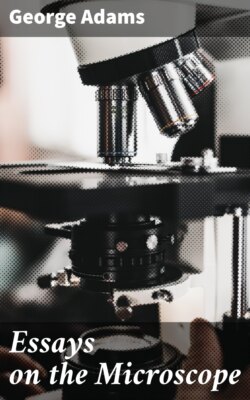Читать книгу Essays on the Microscope - George Comp Adams - Страница 22
На сайте Литреса книга снята с продажи.
TO EXAMINE OPAKE OBJECTS WITH THE LUCERNAL MICROSCOPE.
ОглавлениеThe microscope is represented as mounted, and entirely ready for this purpose, in Fig. 1. Plate III.
To render the use of this instrument easy, it is usually packed with as many of the parts together as possible; it occupies on this account rather more room, but is much less embarrassing to the observer, who has only three parts to put on after it is taken out of its box, namely, the guide for the eye, the stage, and the tube with its magnifier.
But to be more particular, take out the wooden slide A, then lift out the cover and the grey glass from their respective grooves under the slide A.
Put the end N of the guide for the eye L M N into its place, so that it may stand in the position which is represented in this figure.
Place the socket, which is at the bottom of the opake stage, on the bar Q X T, so that the concave mirror o may be next the end D E of the wooden body.
Screw the tubes P O into the end D E. The magnifier you intend to use is to be screwed on the end o of these tubes.
The handle G b, or milled nut, Fig. 2, must be placed on the square end of the pinion a.
Place the lamp lighted before the glass lump n, and the object you intend to examine between the spring plates of the stage, and the instrument is ready for use.
In all microscopes, there are two circumstances which must be particularly attended to; the modification of the light, or the proper quantity to illuminate the object; secondly, the adjustment of the instrument to the focus of the glasses and the eye of the observer. In the use of the lucernal microscope there is a third circumstance, which is the regulation of the guide of the eye, each of which I shall consider by itself.
1. To throw the light upon the object. The flame of the lamp is to be placed rather below the center of the glass semiglobe n, and as near it as possible; the concave mirror o must be so inclined and turned, as to receive the light from the semiglobe; and reflect it thence upon the object; the best situation of the concave mirror, and the flame of the lamp, depends on a combination of circumstances, which a little practice will best point out.
2. To regulate the guide for the eye, or to place the center of the eye piece L, so that it may coincide with the focal point of the lenses, and the axis of vision. Lengthen and shorten the tubes M N by drawing out or pushing in the inner tube, and raising or depressing the eye-piece M L, till you find the large lens, which is placed at the end A B of the wooden body, filled by an uniform field of light, without any prismatic colours round the edge; for, till this piece be properly fixed, the circle of light will be very small, and only occupy a part of the lens; the eye must be kept at the center of the eye-piece L, during the whole of the operation; which may be rendered somewhat easier to the observer, on the first use of the instrument, if he hold a piece of white paper parallel to the large lenses, removing it from or bringing it nearer to them, till he finds the place where a lucid circle, which he will perceive on the paper, is brightest and most distinct, then to fix the center of the eye-piece to coincide with that spot; after which a very small adjustment will set it perfectly right.
3. To adjust the lenses to their focal distance. This is effected by turning the pinion a, the eye being at the same time at the eye-piece L. I often place the grey glass before the large lenses, while I am regulating the guide for the eye, and adjusting for the focal distance.
If the observer, in the process of his examination of an object, advance rapidly from a shallow to a deep magnifier, he will save himself some labour by pulling out the internal tube at O.
The upper part f g r s of the stage, is to be raised or lowered occasionally, in order to make the center of the object coincide with the center of the lens at O.
To delineate objects, the grey or rough ground glass must be placed before the large lenses; the picture of the object will be formed on this glass, and the outline may be accurately taken, by going over the picture with a pencil.
The opake part may be used in the day-time without a lamp, provided the large lenses at A B be screened from the light.
